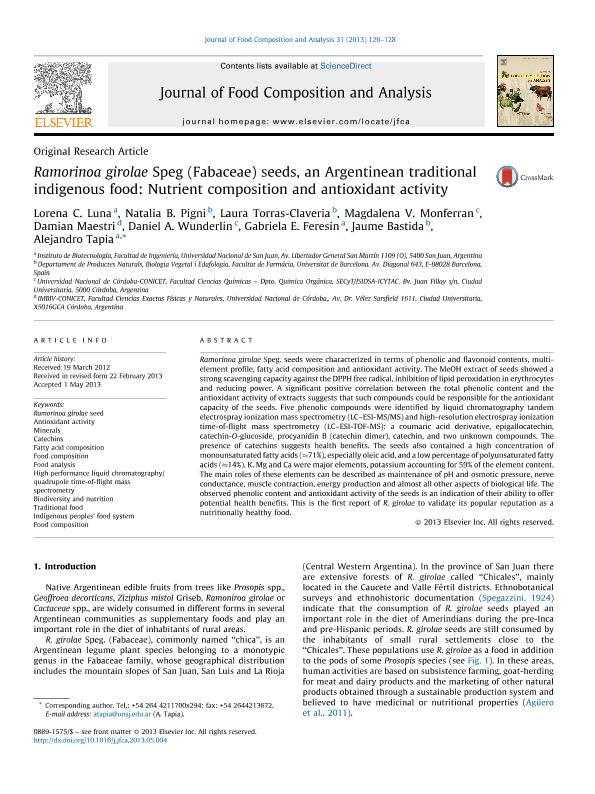Artículo
Ramorinoa girolae Speg (Fabaceae) seeds, an Argentinean traditional indigenous food: Nutrient composition and antioxidant activity
Luna, Lorena Celina ; Pigni, Natalia Belen
; Pigni, Natalia Belen ; Torras Claveria, Laura; Monferran, Magdalena Victoria
; Torras Claveria, Laura; Monferran, Magdalena Victoria ; Maestri, Damian
; Maestri, Damian ; Wunderlin, Daniel Alberto
; Wunderlin, Daniel Alberto ; Feresin, Gabriela Egly
; Feresin, Gabriela Egly ; Bastida, Jaume; Tapia, Alejandro
; Bastida, Jaume; Tapia, Alejandro
 ; Pigni, Natalia Belen
; Pigni, Natalia Belen ; Torras Claveria, Laura; Monferran, Magdalena Victoria
; Torras Claveria, Laura; Monferran, Magdalena Victoria ; Maestri, Damian
; Maestri, Damian ; Wunderlin, Daniel Alberto
; Wunderlin, Daniel Alberto ; Feresin, Gabriela Egly
; Feresin, Gabriela Egly ; Bastida, Jaume; Tapia, Alejandro
; Bastida, Jaume; Tapia, Alejandro
Fecha de publicación:
08/2013
Editorial:
Elsevier
Revista:
Journal Of Food Composition And Analysis
ISSN:
0889-1575
Idioma:
Inglés
Tipo de recurso:
Artículo publicado
Clasificación temática:
Resumen
Ramorinoa girolae Speg. seeds were characterized in terms of phenolic and flavonoid contents, multielement profile, fatty acid composition and antioxidant activity. The MeOH extract of seeds showed a strong scavenging capacity against the DPPH free radical, inhibition of lipid peroxidation in erythrocytes and reducing power. A significant positive correlation between the total phenolic content and the antioxidant activity of extracts suggests that such compounds could be responsible for the antioxidant capacity of the seeds. Five phenolic compounds were identified by liquid chromatography tandem electrospray ionization mass spectrometry (LC-ESI-MS/MS) and high-resolution electrospray ionization time-of-flight mass spectrometry (LC-ESI-TOF-MS): a coumaric acid derivative, epigallocatechin, catechin-O-glucoside, procyanidin B (catechin dimer), catechin, and two unknown compounds. The presence of catechins suggests health benefits. The seeds also contained a high concentration of monounsaturated fatty acids (71%), especially oleic acid, and a low percentage of polyunsaturated fatty acids (14%). K, Mg and Ca were major elements, potassium accounting for 59% of the element content. The main roles of these elements can be described as maintenance of pH and osmotic pressure, nerve conductance, muscle contraction, energy production and almost all other aspects of biological life. The observed phenolic content and antioxidant activity of the seeds is an indication of their ability to offer potential health benefits. This is the first report of R. girolae to validate its popular reputation as a nutritionally healthy food.
Palabras clave:
Ramorinoa Girolae Seed
,
Antioxidant Activity
,
Minerals
,
Catechins
,
Fatty Acid Composition
,
Food Composition
,
Food Analysis
,
High Performance Liquid Chromatography/Quadrupole Time-Of-Flight Mass Spectrometry
,
Biodiversity And Nutrition
,
Traditional Food
,
Indigenous Peoples Food System
Archivos asociados
Licencia
Identificadores
Colecciones
Articulos(ICYTAC)
Articulos de INST. DE CIENCIA Y TECNOLOGIA DE ALIMENTOS CORDOBA
Articulos de INST. DE CIENCIA Y TECNOLOGIA DE ALIMENTOS CORDOBA
Articulos(IMBIV)
Articulos de INST.MULTIDISCIPL.DE BIOLOGIA VEGETAL (P)
Articulos de INST.MULTIDISCIPL.DE BIOLOGIA VEGETAL (P)
Articulos(SEDE CENTRAL)
Articulos de SEDE CENTRAL
Articulos de SEDE CENTRAL
Citación
Luna, Lorena Celina; Pigni, Natalia Belen; Torras Claveria, Laura; Monferran, Magdalena Victoria; Maestri, Damian; et al.; Ramorinoa girolae Speg (Fabaceae) seeds, an Argentinean traditional indigenous food: Nutrient composition and antioxidant activity; Elsevier; Journal Of Food Composition And Analysis; 31; 1; 8-2013; 120-128
Compartir
Altmétricas



